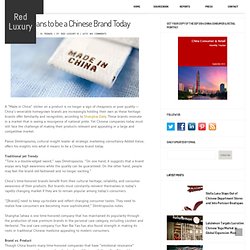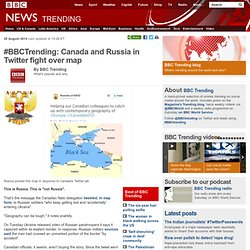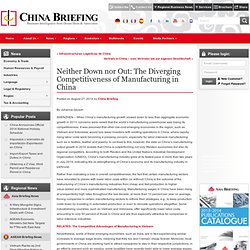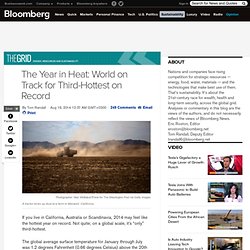

Shifting-Economics-Glb-Mfg-ex1_inline_tcm80-167414.png (PNG Image, 460 × 274 pixels) Fashion made-in-China: fine for everyone but the Chinese. Milan (AFP) - It has been called fashion's dirty little secret but according to Miuccia Prada, soon everybody will be doing it.

Made-in-China's just fine with Prada's supremo and a host of other influential industry figures. But for Chinese companies and designers seeking to become global style players, producing high-end clothing on home soil is complicated. Trade barriers, brand perception issues and the sourcing of certain fabrics combine to form an obstacle to them competing internationally with an exclusively homegrown product.
Uma Wang, China's best-known international designer, says the nature of her business dictates a 40 percent made-in-China, 60 percent made-in-Italy production model. The creative work including production of samples is mostly done at Wang's headquarters in Shanghai. For Wang, whose sales are mostly outside China, import/export taxes are the key issue. View gallery A model presents a creation from the Uma Wang collection during the 2015 Spring / Summer Milan Fashi … What It Means to be a Chinese Brand Today.
A “Made in China” sticker on a product is no longer a sign of cheapness or poor quality — China’s venerable homegrown brands are increasingly holding their own as these heritage brands offer familiarity and recognition, according to Shanghai Daily.

These brands resonate in a market that is seeing a resurgence of national pride. Yet Chinese companies today must still face the challenge of making their products relevant and appealing in a large and competitive market. Panos Dimitropoulos, cultural insight leader at strategic marketing consultancy Added Value, offers his insights into what it means to be a Chinese brand today. Traditional yet Trendy “Time is a double-edged sword,” says Dimitropoulos. “On one hand, it suggests that a brand enjoys very high awareness while the quality can be guaranteed. China’s time-honored brands benefit from their cultural heritage, reliability, and consumer awareness of their products.
Brand vs. Image credit: blogs.ubc.ca. #BBCTrending: Canada and Russia in Twitter fight over map. 28 August 2014Last updated at 15:28 ET By BBC Trending What's popular and why Russia posted this map in response to Canada's Twitter jab This is Russia.

This is "not Russia". That's the message the Canadian Nato delegation tweeted, in map form, to Russian soldiers "who keep getting lost and 'accidentally' entering Ukraine". "Geography can be tough," it notes snarkily. On Tuesday Ukraine released video of Russian paratroopers it says it captured within its eastern border. Neither Down nor Out: The Diverging Competitiveness of Manufacturing in China - China Briefing News. By Johanna Grusch SHENZHEN – When China’s manufacturing growth slowed down to less than aggregate economic growth in 2013, concerns were raised that the world’s manufacturing powerhouse was losing its competitiveness.

It was assumed that other low-cost emerging economies in the region, such as Vietnam and Indonesia, would lure away investors with existing operations in China, where rapidly rising labor costs were becoming a pressing concern, especially for labor-intensive manufacturing such as in textiles, leather and jewelry. The Year in Heat: World on Track for Third-Hottest on Record. If you live in California, Australia or Scandinavia, 2014 may feel like the hottest year on record.

Not quite; on a global scale, it’s “only” third-hottest. The global average surface temperature for January through July was 1.2 degrees Fahrenheit (0.66 degrees Celsius) above the 20th century average, tying with 2002 as the third warmest in records going back to 1880, according to National Climatic Data Center data released today. Hottest Years on Record The greatest share of global warming in recent years has been absorbed by the oceans. The beginnings of an El Nino warming pattern in the Pacific Ocean earlier this year threatened to stir up some of the heat. Thirteen of the 14 hottest years on record have all occurred in the 21st century. Stack of Broken Records Click on the image above for a version with better resolution. Drought conditions worsened across the U.S. The world is hot, and getting hotter.
Sea of Red More from Tom Randall: The Shifting Economics of Global Manufacturing. Cost Competitiveness: A Country View For the better part of three decades, a rough, bifurcated conception of the world has driven corporate manufacturing investment and sourcing decisions.

Latin America, Eastern Europe, and most of Asia have been viewed as low-cost regions. The U.S., Western Europe, and Japan have been viewed as having high costs. But this worldview now appears to be out of date. Years of steady change in wages, productivity, energy costs, currency values, and other factors are quietly but dramatically redrawing the map of global manufacturing cost competitiveness. In some cases, the shifts in relative costs are startling.
To understand the shifting economics of global manufacturing, The Boston Consulting Group analyzed manufacturing costs for the world’s 25 leading exporting economies along four key dimensions: manufacturing wages, labor productivity, energy costs, and exchange rates.